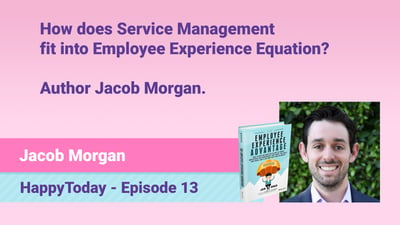Sami and Pasi talk about the range of factors that drive employees to a better employee experience, as well as the negative factors that reduce happiness, productivity and increase lost time.
The data from this episode has been taken from the 'Happiness Score Report' and focuses on the scores received for various IT incidents where people have been happy with services or unhappy, leading to decreased productivity and loss time.
Starting on a positive note, the biggest factor that makes an employee happy is the speed of service. This doesn't mean the speed of service from the agent in fixing the problem, but the speed of service from the moment they first had a problem to the moment it has been fixed. This means, from when the user first encountered a problem, how quick was it to find relevant information, contact numbers, portal information etc. to when the problem has be solved.
The second factor that leads to higher happiness amongst employees is the attitude of the agent resolving their IT issue. Employees appreciate good, human service - people who have a positive attitude and who is interested in the case.
The third factor is how good the skills of the agent are. This has been a growing trend since the start of HappySignals. End-users are starting to become more skilful with their tech, therefore they are expecting the agent who is helping them to be even more skilful with IT incidents.
On the other hand, the biggest negative factor that is impacting employee experience is the speed of service. If an employee isn't getting their ticket resolved quick enough or within the time they need it to be solved, then they'll have a negative experience.
The second biggest negative factor is when an employees' ticket isn't resolved at all. There can be many reasons for this, from an end-users perspective.
There have been many cases where people have been able to find the answers to their problems through Google or other services before the agent has fixed their problem. On the other hand, end-users can also feel that the ticket may be resolved, but in fact it was not the right fix.
Other reasons may be that the instructions have been to hard to follow, the attitude of the agent was not good or helpful or a possible team within the service desk is not responsible for this type of ticket.
The final biggest factor, which can also be related to the factor above, is the "I had to explain my case several times". Something that is linked to this problem is the earlier podcast on reassignment counts.
Through HappySignals product, you are able to make these problems actionable and work out ways to solve these problems. By drilling down into the data and working out which areas to focus on improving. For example moving certain tickets straight to the right people. As well as this, customers can compare their scores to the industry benchmark in HappySignals analytics, to see how their services are really performing.
For example, ServiceNow customers can use the workflow designer - when feedback is coming in and has a lower score you are able to label it as a certain factor (e.g. Agents skill issues). You can then use the experience data to bring back it back to your ideas and platform.
If you would like to access all the data that has been used in the post, download a copy of the 'Happiness Score Report' here.



